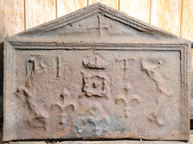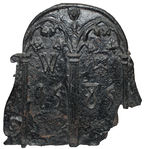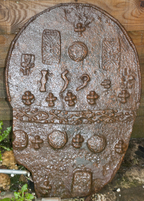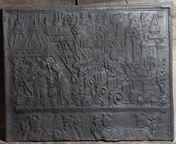-
604
Description: Arched rectangular with curved shoulders; cavetto-moulded edging (top and sides) with twin scrolls on inside corners, and scalloped bottom edge; armorial; shield (32 quarters), mantling, supporters (bull and crowned lion), coronet, motto, 2 helms and crests (a bear’s head erased and ducally gorged, and a bear and ragged staff).
Notes: The impaled arms appear to be those of the Earldom of Huntingdon. The crests are of Hastings and Dudley, suggesting they are of Henry, 3rd Earl (c.1535-95), and his wife, Katherine (1548-1620), daughter of John Dudley, Duke of Northumberland. She was a child when they married in 1553. This is an incomplete casting, the full version of which includes a bottom panel with a repeated guilloche design. Christie's Masters and Makers Sale, South Kensington, 30 Nov 2010, lot 516 (£4,375).
Copies of this fireback are known.
Inscription: IN VERITATE VICTORIA (illegible, but verified on other castings)
Arms: Hastings, earl of Huntingdon, impaling Dudley
- Decoration tags:
- rectangular with round arch (shape)
- cavetto (edging)
- whole carved pattern
- armorial
Manufactured: in the late-16th century in England.
Current location: not known.
- Attached to series:
- Personal armorial firebacks
-
1015
Description: Rectangular with two-stepped top; twisted rope edging (top and sides); twisted rope extensions enclosing intermediate step with rope continued parallel to sides; central rope octagram with reversed date above between repeated inverted shield shapes off-set (left higher than right); the shield blazon: barry wavy impaling quarterly, overlaid with a small bird stamp and an indistinct ?bird shape in the top left quarter as viewed; within the rope, a roughly parallel arrangement of 23 double-loop-patterned stamps, with the faint impression of an additional stamp in the top right corner of the arrangement; outside the loop stamps and partially overlying the vertical rope extensions, the impressions of two classically designed firedogs with Ionic capitals and fluted pilasters, bearing the date 1594, but with the '1' missing; the fluting on the pilasters has been overlaid by the repeated impression of a turned peg.
Notes: A large and remarkably elaborate fireback: the octagram, a device seen more commonly on French firebacks than on English ones, suggests an apotropaic purpose; the impression of the firedogs was clearly made after the laying of the rope lengths and impressed less deeply as the rope impression has not been obliterated by the firedog on the left side. A fireback with the same loop stamps bears the same date using the same numerals but impressed the correct way round. Currently obscured behind a wood stove.
Inscription: 4951 [5 reversed] / 594 594
- Decoration tags:
- stepped (shape)
- rope (edging)
- simple stamps
- carved stamps
- individual numbers
- apotropaic
- armorial
- text
- objects
Manufactured: in 1594 in the Weald area of England.
Current location: Fyning Manor, Rogate, West Sussex, England.
-
667
Description: Armorial within complex ovolo moulded edging (top and sides); quartered shield, helm, crest and mantling; plain panel below.
Notes: The arms can be identified from the first four quarters on the memorial to Raffe Maynard, d.1613, in St Albans Cathedral; quarterly, 1, Maynard: argent, a chevron azure between three sinister hands couped at the wrist gules; 2, Filleigh: gules, a fess vairy between six crosses formy or; 3, Harris/Hawes/Hewish: gules fretty argent a canton of the second; 4, Lyons: argent a chevron sable between three lions dormant coward gules; the crest, a stag statant, is of Maynard. The Maynards, originally from Devon, were a large family in Rotherfield, and Richard Maynard (d.1619) had an interest in Old Mill, Mayfield, as well as in Birchden forge, and probably Hamsell furnace. An example without the extension panel at the bottom has been noted. A larger fireback with the same arms, and probably by the same pattern maker, can also be seen (no. 144).
Copies of this fireback are known.
Arms: Maynard
- Decoration tags:
- rectangular with round arch (shape)
- ovolo (edging)
- whole carved pattern
- armorial
Manufactured: in the late-16th century in the Weald area of England.
Current location: Hole Park, Rolvenden, Kent, England.
- Attached to series:
- Personal armorial firebacks
- Ornate border series
- Maynard arms firebacks
-
1081
Description: Arch-shaped, the arch consisting of eight, straight, ovolo-moulded sections; longer ovolo-moulded pieces form the lower sides of the fireback; in the centre a circular garter enclosing the Tudor arms of England; above, a crown; the date was carved on a single stamp and placed below left of the crown.
Notes: From other examples it is apparent that the crown is formed from a separate stamp to the shield and garter. Formerly at the Anchor Inn, Hartfield, Sussex; later at the Carnegie Science Center, Pittsburgh, PA, it was deaccessioned in 2003 from the Carnegie Museum of Natural History in Pittsburgh and sold at auction by Skinner, Inc. of Marlborough, MA. Cropped illustration from Schubert 1950.
Inscription: 1589 / HONI SOIT qVI MAL I PANSE
Arms: Tudor royal
- Decoration tags:
- carved stamps
- date stamp
- heraldic
- armorial
- royal
- text
Manufactured: in 1589 in the Weald area of England.
Current location: not known.
- Attached to series:
- 1589 series
- Tudor royal armorial firebacks
-
683
Description: Rectangular; twisted rope edging (top and sides); top left and right, Tudor rose surmounted by a crown (separate stamps); right of centre, irregular pentagram formed of a repeated length of twisted rope enclosing a Tudor rose; on either side of top point of pentagram, a triple-loop stamp irregularly spaced.
Notes: The pentagram has both Christian and occult symbolism. The fleur and the rose and crown have been seen on another fireback.
Copies of this fireback are known.
- Decoration tags:
- rectangular (shape)
- rope (edging)
- simple stamps
- carved stamps
- heraldic
- apotropaic
- objects
Manufactured: in the late-16th century possibly in the Weald area of England.
Current location: in private hands, Sevenoaks, Kent, England.
- Attached to series:
- Rope design firebacks
- Looped fleur series
-
919
Description: Arched rectangular shape; rope edging (top and sides); undulating floriate design across top of rectangle, below which are alternating roses (4) and ?crowned cross stamps (5); the same cross and rose stamps decorate the arch, three crosses on each side of a rose at the top; at the base of the arch is a row of four stamps formed of a double figure-of-eight joined by opposed concave curves; the same stamps (3), rotated 90 degrees, are arranged in a row down the left side of the plate.
Notes: Similar undulating floriate designs have been seen on late-medieval and sixteenth century stools, suggesting a possible source. A fireback with the same loop stamps bears the same date using the same numerals but impressed in reverse. Unusually, the decoration down the left side is not repeated down the right side.
Inscription: 1594
- Decoration tags:
- rectangular with round arch (shape)
- rope (edging)
- simple stamps
- carved stamps
- individual numbers
- text
- plants
- objects
Manufactured: in 1594 in the Weald area of England.
Current location: Weald and Downland Living Museum, Singleton, West Sussex, England.
(part of the Weald and Downland Living Museum museum group)
- Attached to series:
- Loop stamp (early) series
- Furniture stamp firebacks
-
689
Description: Rectangular with pediment; ovolo moulded edging inside top of pediment and inside top and sides of rectangle; centre top, four-petal rose and crown with three fleurs-de-lys below; at either end, stamps made from two parts of a wreath (the middle section missing); in the pediment a cross.
Notes: The wreaths from which the stamps have been disassembled can be seen complete on two other firebacks, and the rose and crown is a common stamp on a large series of early firebacks.
Inscription: I T
- Decoration tags:
- triangular arched (shape)
- cavetto (edging)
- carved stamps
- individual letters
- heraldic
- royal
- text
- objects
Manufactured: in the late-16th century in the Weald area of England.
Current location: in private hands, Slaugham, West Sussex, England.
- Attached to series:
- Royal series
- Royal (wreath) series
-
694
Description: Arched shape with scrolled side brackets; astragal edging on arch; bipartite design with side pilasters and a central pilaster surmounted by two gothic traceried arches within each of which are two roses and two fleurs-de-lys; below left arch, letter ‘W’ (possibly ‘WY’ monogram) above first half of date; below right arch, shield bearing arms of the Borough of Stratford-upon-Avon above second half of date.
Notes: The combination of the monogram and the arms of Stratford suggest an individual with a formal office within the borough; a mixture of Gothic and Classical elements; damage to bottom right side.
Inscription: W [Y?] / 15 85
Arms: Borough of Stratford-upon-Avon
- Decoration tags:
- rounded arched (shape)
- astragal (edging)
- whole carved pattern
- individual letters
- individual numbers
- heraldic
- architectural
- text
Manufactured: in 1585 in England.
Current location: Nash's House, Chapel Street, Stratford-upon-Avon, Warwickshire, England.
(part of the Shakespeare's Birthplace Trust museum group)
- Attached to series:
- Miscellaneous pattern firebacks
- Date & initials firebacks
- Civic firebacks
-
1090
Description: Fragment; probably originally arched rectangular shape with twisted rope edging (only the arch and a section below surviving); below arch, band of repeated short stamps with undulating vine decoration, randomly impressed so that the undulations do not join consistently; above the band, line of ?crowned cross stamps repeated five times; above them, the date (the 3 uncertain) between two vertically-aligned stamps formed of a double figure-of-eight between opposed concave curves; above, a rose stamp between two vertical rectangular stamps of indeterminate design, with a ?crowned rose stamp above; below the band, a line of alternate rose and ?crowned cross stamps, three of each; below, a ?crowned cross stamp and a rectangular stamp.
Notes: Most of the stamps have been seen on a small group of firebacks of the 1590s concentrated in the western Weald.
Inscription: 1593[?]
- Decoration tags:
- rope (edging)
- carved stamps
- individual numbers
- text
- plants
- objects
Manufactured: in 1593 in the Weald area of England.
Current location: in private hands, Ticehurst, East Sussex, England.
- Attached to series:
- Loop stamp (early) series
-
703
Description: Rectangular; cavetto moulded edging; pictorial scene of the siege of Bethulia, with Judith placing the severed head of Holofernes into the bag held by her maid; in the lower panel are the top parts of four knightly figures.
Notes: The design is after one by the pattern-maker, Philipp Soldan, and derived from a woodcut of an engraving by Israhel van Meckenhem; it illustrates scenes from the Apocryphal book of Judith.
- Decoration tags:
- rectangular (shape)
- cavetto (edging)
- whole carved pattern
- pictorial
- biblical
- humans
Manufactured: in the late-16th century in the Eifel area of Germany.
Current location: Tiverton Castle, Tiverton, Devon, England.
- Attached to series:
- Stoveplates

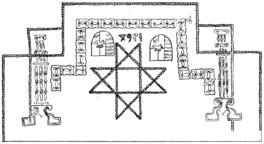

.jpg)


